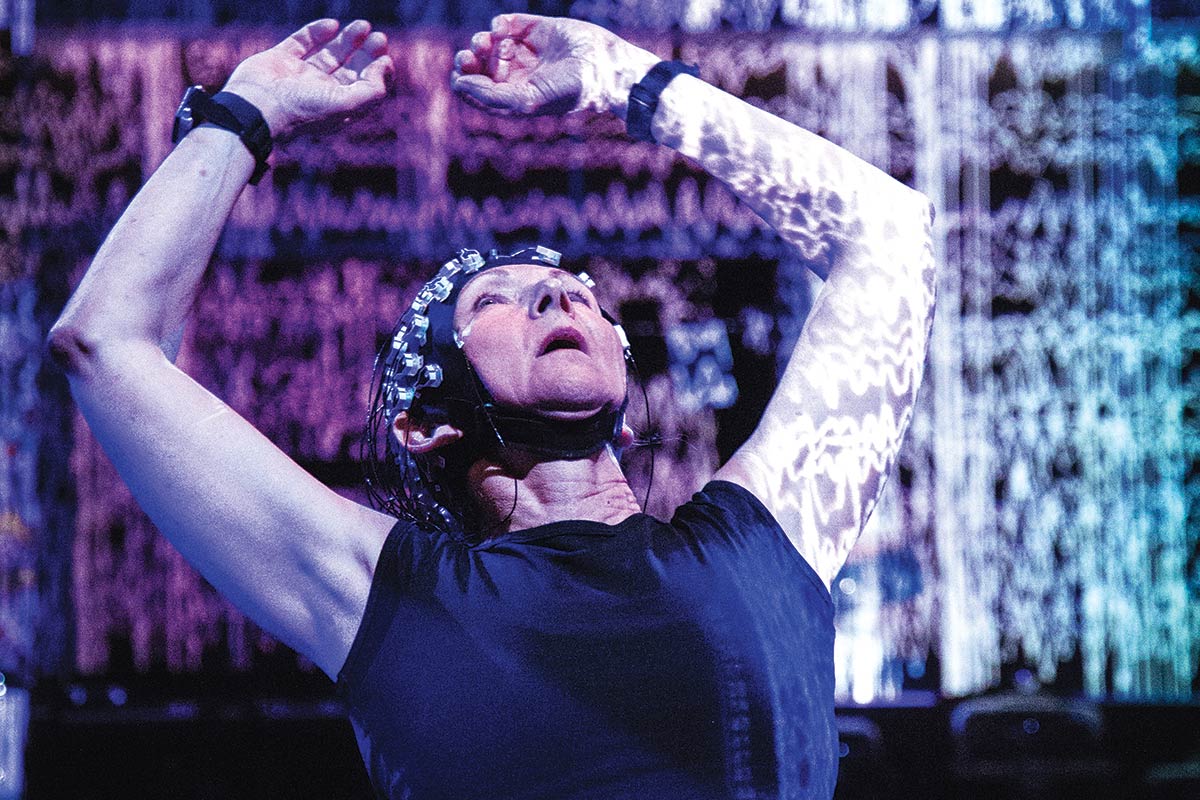Dancing With Science

Becky Valls is racing an unseen enemy, trench coat and bare feet flying as she runs, swoops and dives through a small space at the Jose Quintero Theatre, stage lights flickering in time with the shifting brainwaves projected behind her.
Art, meet science.
Valls, associate professor of dance at the University of Houston, and neuroscientist and engineer Jose Luis Contreras-Vidal are studying how creativity affects the brain.
“Every time she performs, she is creating,” Contreras-Vidal said. “We want to know what it takes to be creative. We want to understand the process, and maybe train people to get better at it.”
Contreras-Vidal develops algorithms based on electrical activity in the brain; much of his research involves helping people with disabilities use bionic hands or regain movement by “walking” in exoskeletons powered by their own thoughts.
The work with Valls is different, part of the emerging discipline of neuroaesthetics, which combines neuroscience and the study of art, creative movement and perception. It follows a project last year with artist Dario Robleto at the Menil Collection, when Contreras-Vidal offered museum visitors the opportunity to record brain activity as they viewed Robleto’s artwork.
Contreras-Vidal, Hugh Roy and Lillie Cranz Cullen Distinguished Professor of electrical and computer engineering, and his research group have written two papers based on their work at the Menil, one about the technical aspects and the second to interpret the brain activity they recorded.
He needs to gather data from additional performers before drawing conclusions about the dance collaboration. But Valls already has found a connection to her own research, which involves teaching science through dance.
In addition to teaching at UH, she works with younger students as a teaching artist, primarily through Young Audiences of Houston. For the past five years, she has trained teachers at the UH Charter School, which serves students through fifth grade, to help children illustrate scientific principles through dance.
Movement alone floods the brain with oxygen and can help students focus — that’s why teachers may have them perform jumping jacks or other exercise during difficult classes.
Dance goes further.
“Because they are creating dances based on science, the students have to deepen their understanding,” Valls said. “They have to pull in other information. I’m proposing that because they learn with more parts of their brain involved, it will improve retention and deepen the learning of science.”
Valls hasn’t published her findings and hopes to find a collaborator from another discipline to extend her analysis. Interest in that sort of interdisciplinary work is growing, as James Rosengren, deputy director of Blaffer Art Museum, found last year when he reached out to UH faculty to participate in Blaffer’s Innovation Series, a series of public programs developed around the exhibition “Janet Biggs: Echo of the Unknown,” which dealt with memory loss and the role of memory in forming identity.
Valls responded, planning to bring UH Charter School students to perform a dance about Alzheimer’s disease. When Rosengren suggested she work with Contreras-Vidal, she was intrigued by the combination of art and science.
“My belief is that dance is a human social interaction that brings a different kind of experience to learning science,” she said. “That’s what Pepe (Contreras-Vidal) is trying to look at, how moving your whole body deepens an experience.”
The two had met several years earlier, when a dancer from the University of Maryland came to UH to work with Contreras-Vidal on a project to study brain activity during expressive movements, aimed at better understanding movement.
The tools for understanding emotion and creativity are similar, so Valls was fitted with motion sensors and a wireless skullcap embedded with 64 electrodes to track both her physical movements and the emotions behind them.
The dance, an intense eight-minute solo that Valls describes as expressing anger and fear but also survival, is one of her signature compositions, and she and other dancers have performed it across the United States. The emotion made it a good choice for the project, she said, and her bone-deep familiarity with it may help in interpreting the EEG results.
But simply wearing the skullcap inevitably had an effect.
“I think it has to, because during the performance you are always responding to the audience, and they were watching my brainwaves,” she said. “The light was getting more intense. But it was secondary because just to perform takes all of your faculties.”
And that — “all of your faculties,” the workings of the whole brain — is what interests Contreras-Vidal.
Each creative mind will be different, but the ultimate results could hold implications for all of us.
“If we knew how creativity comes into play,” he said, “maybe we can become more creative.”